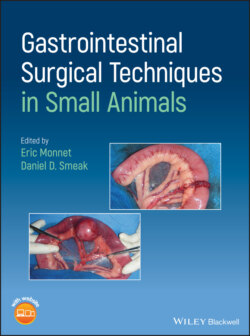Читать книгу Gastrointestinal Surgical Techniques in Small Animals - Группа авторов - Страница 53
3.5.4 Parker–Kerr Oversew
ОглавлениеThis continuous inverting pattern is used to “blind end” a tubular organ such as bowel or uterine stumps (Figure 3.6). To reduce contamination and aid in needle purchase, a large hemostatic clamp is first placed perpendicular to the long axis of the tubular organ. Any remaining organ tissue extending past the jaws of the clamp is removed. Starting at either the mesenteric or antimesenteric surface, a loose continuous Cushing suture pattern is placed catching 3–4 mm of bowel wall with each needle bite and running at least 3 mm from the edge of the clamp. Once the loose Cushing pattern is complete, the jaws of the clamp are partially opened releasing the incised bowel edges, while the suture end with the needle is slowly tensioned away from the side closest to the clamp hinge. The clamp is removed and the suture line is tensioned from both sides to completely invert the stump edges. The needle is then reversed and a Lembert pattern is placed and tied to the original free suture end to form a leak‐proof double inverted stump.
Figure 3.6
Figure 3.7
